Do Raccoons Live in Sewers?
Raccoons are highly adaptable mammals known for utilizing various environments, both natural and man-made. While urban legends suggest raccoons may inhabit sewers, evidence indicates this is not typical behavior.
Raccoons prefer elevated nesting sites like tree cavities, attics, and basements. Sewer systems pose significant risks, such as flooding and lack of suitable shelter, making them less attractive to these animals.
Scientific studies and camera traps have occasionally captured raccoons near sewer entrances, but they generally do not reside there. Observing their nesting habits in urban environments offers more accurate insights into their behavior.
Further examination reveals interesting patterns in their adaptability.
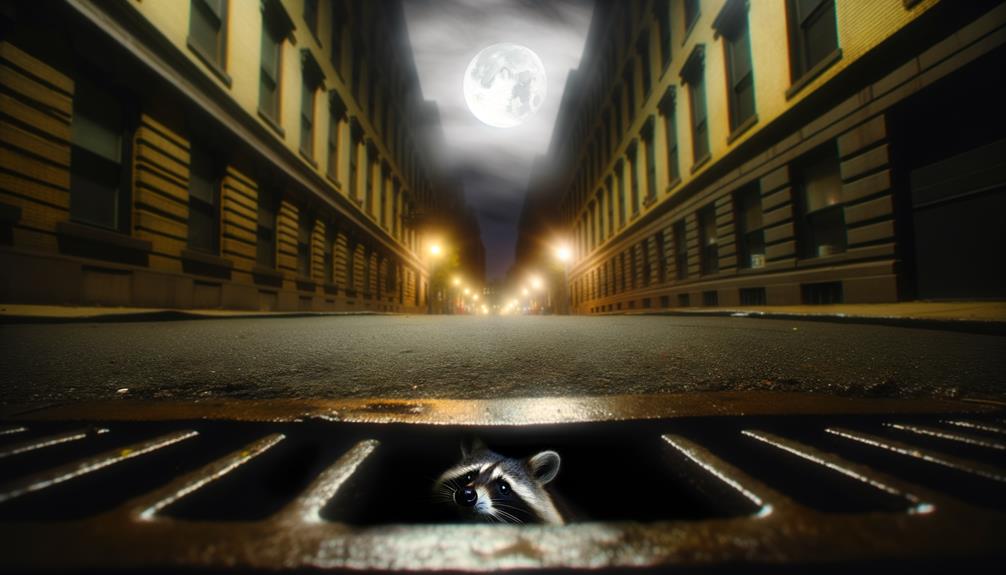
Key Takeaways
- Raccoons prefer above-ground nests and rarely inhabit sewers.
- Limited evidence supports raccoons living in sewer systems.
- Sewers lack the shelter and safety raccoons seek for nesting.
- Raccoons may explore sewers but not use them as primary homes.
- Urban raccoons favor attics, basements, and under decks for nesting.
Raccoon Habitats
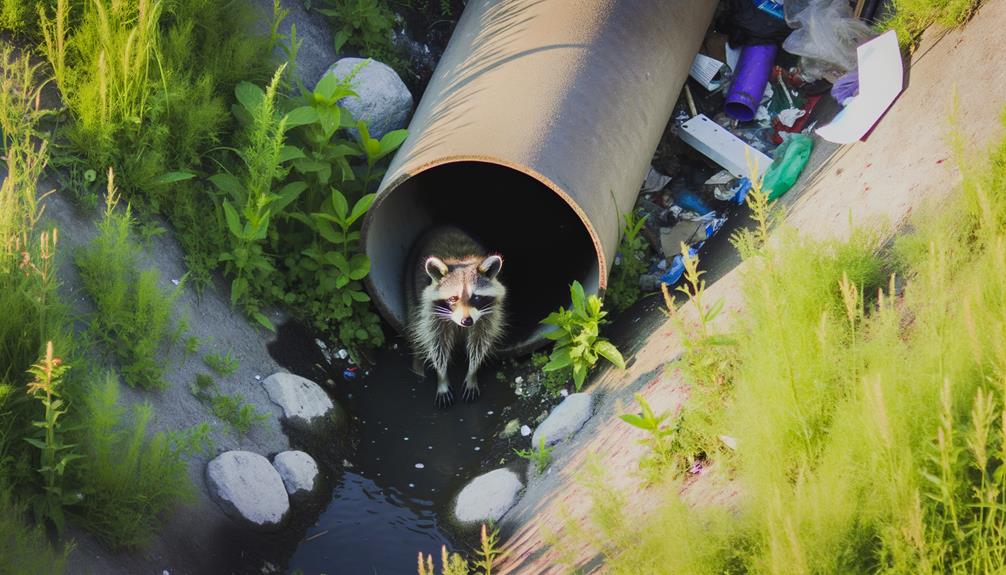
Raccoons (Procyon lotor) are highly adaptable mammals that can thrive in a diverse range of habitats, including urban, suburban, and rural environments. Their versatility is evident in their ability to exploit various ecological niches, from forests and wetlands to city parks and residential areas.
Scientific observations have documented raccoons utilizing natural shelters such as tree cavities and burrows, as well as anthropogenic structures like attics, basements, and storm drains. This adaptability is facilitated by their omnivorous diet, which allows them to consume a wide array of food sources ranging from fruits and insects to human refuse.
Their behavioral flexibility and opportunistic feeding habits underscore their success in colonizing both natural and human-altered landscapes, thereby making them a ubiquitous species in North America.
Urban Legends and Myths
Numerous urban legends and myths have emerged regarding the presence of raccoons in human environments, often fueled by anecdotal accounts and sensationalized media reports. These narratives typically portray raccoons as ubiquitous scavengers, infiltrating sewers and urban infrastructure.
While raccoons are highly adaptable and can thrive in various urban settings, scientific investigations reveal limited evidence supporting their widespread habitation of sewer systems. Most reports are based on isolated incidents rather than consistent behavioral patterns.
Research indicates that raccoons prefer accessible, above-ground environments for nesting, such as attics, chimneys, and abandoned buildings.
The perpetuation of these myths can overshadow genuine ecological studies, emphasizing the need for critical examination and evidence-based understanding of raccoon behavior in urban ecosystems.
Sewer Systems Explained
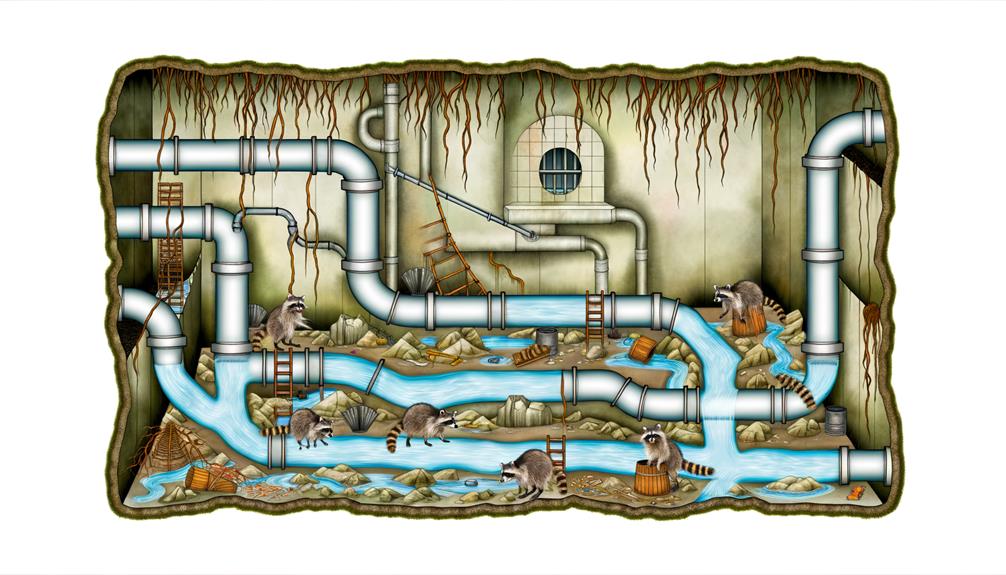
Sewer systems, integral to urban infrastructure, are designed to manage and transport wastewater away from residential, commercial, and industrial areas. These systems are essential for maintaining public health and environmental integrity. They consist of a network of pipes, pumping stations, and treatment facilities that collectively work to remove and treat sewage and stormwater. Functionally, sewer systems are categorized into sanitary sewers, storm sewers, and combined sewers.
| Component | Function |
|---|---|
| Sanitary Sewers | Transport household waste |
| Storm Sewers | Manage rainwater runoff |
| Combined Sewers | Handle both wastewater types |
| Treatment Plants | Purify and recycle water |
Effective sewer systems prevent flooding, reduce pollution, and support sustainable urban living. Their engineering complexity ensures reliability and efficiency in wastewater management.
Raccoon Adaptability
Raccoons exhibit remarkable adaptability to urban environments. They utilize their resourcefulness and advanced survival skills to navigate human-altered landscapes.
Studies have documented their ability to exploit diverse food sources, ranging from household waste to small urban fauna, demonstrating their opportunistic feeding behavior.
Their cognitive flexibility and physical dexterity enable them to access and inhabit various urban structures, including sewer systems. This enhances their survival and proliferation in metropolitan areas.
Urban Environment Adaptation
In urban environments, raccoons exhibit remarkable adaptability, utilizing a variety of resources and habitats, including sewers, to thrive amidst human settlements. This adaptability is evidenced by their ability to exploit anthropogenic structures and food sources.
Urban raccoons have been observed nesting in attics, chimneys, and abandoned buildings, demonstrating their flexibility in habitat selection. Research indicates that raccoons possess an enhanced problem-solving ability, enabling them to navigate complex urban landscapes efficiently.
Moreover, raccoons' nocturnal behavior reduces human-wildlife conflicts, allowing them to forage and move with minimal disturbance. Studies have shown that urban raccoon populations can be denser than their rural counterparts, underscoring their successful adaptation to city life and the unique challenges it presents.
Resourcefulness and Survival Skills
With their remarkable cognitive abilities and versatile physical traits, raccoons exhibit a high degree of resourcefulness and adaptability, enabling them to survive in diverse and challenging environments.
Studies indicate that raccoons possess advanced problem-solving skills, which facilitate their ability to exploit various food sources and habitats. Their dexterous forepaws allow them to manipulate objects and open containers, increasing their access to human-provided resources.
Moreover, raccoons demonstrate remarkable spatial memory, aiding in navigation and resource location. These survival skills are particularly evident in urban settings, where raccoons have adapted to utilizing sewers as temporary shelters.
This adaptability underscores the species' capacity to thrive despite the pressures of urbanization and habitat fragmentation, highlighting their resilience and ecological plasticity.
Nesting Preferences
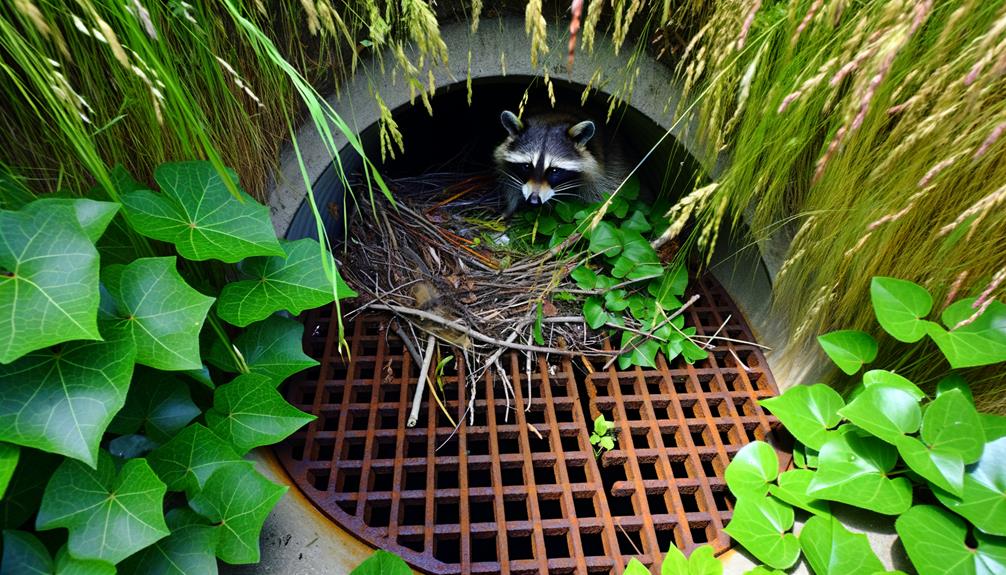
Urban environments provide raccoons with a diverse array of nesting sites, ranging from tree cavities to abandoned buildings, which contribute to their adaptability and survival. Raccoons exhibit a preference for locations that offer protection from predators and harsh weather conditions. Studies indicate that raccoons frequently select dens that are elevated, such as attics or hollow trees, to avoid ground-level threats.
Additionally, they are known to exploit human-made structures, such as attics, garages, and even chimneys, for nesting purposes. Research underscores the species' capability to adapt its nesting behavior based on environmental variables, ensuring reproductive success. The availability of various nesting sites in urban areas notably enhances raccoons' ability to thrive in these settings.
Food Sources in Sewers
Sewers provide raccoons with a surprisingly diverse array of food sources, including organic waste, small aquatic organisms, and discarded human food. These environments offer consistent access to nutrients, enabling raccoons to sustain themselves effectively. Studies indicate that raccoons are highly adaptable foragers, capable of exploiting various food niches within urban sewer systems.
| Food Source | Emotional Impact |
|---|---|
| Organic Waste | Disturbing |
| Small Aquatic Organisms | Fascinating |
| Discarded Human Food | Concerning |
| Insects and Rodents | Disconcerting |
| Plant Debris | Unexpected |
This adaptability underscores their resilience and ability to thrive in unconventional habitats. Understanding these food sources is essential for urban wildlife management and highlights the complex interactions between human activities and wildlife behaviors.
Risks of Sewer Living
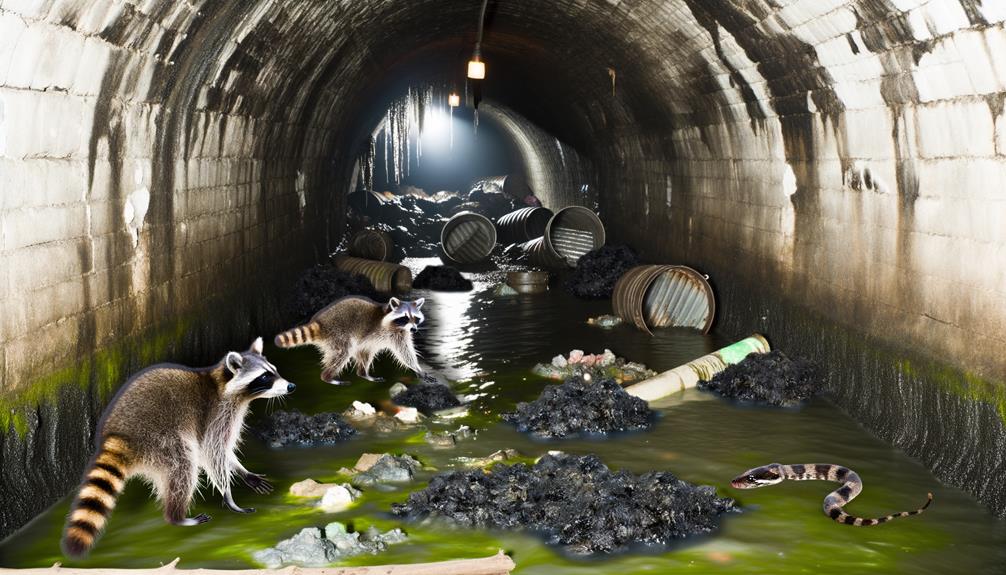
Frequently, residing in sewer systems exposes raccoons to significant health hazards and environmental stressors. Pathogens prevalent in sewer environments, such as Leptospira and Salmonella, pose severe risks of infection.
Additionally, raccoons may suffer from parasitic infestations, including roundworms and ticks. The lack of adequate ventilation and natural light in sewers can lead to respiratory issues and impaired circadian rhythms, respectively.
Moreover, chemical pollutants, ranging from household waste to industrial effluents, can cause toxic exposure and long-term health deterioration. Finally, the physical environment of sewers, characterized by narrow passageways and fluctuating water levels, increases the risk of injury or drowning.
These factors collectively underscore the considerable dangers associated with raccoons inhabiting sewer systems.
Comparative Habitats
In examining the comparative habitats of raccoons, distinctions between urban and rural living environments are paramount, as both settings provide unique advantages and challenges for the species. Urban areas often offer abundant food sources and shelter options, such as sewers and attics, while rural environments typically provide more natural nesting sites like tree cavities and burrows.
Understanding these habitat preferences is essential for developing effective wildlife management and conservation strategies.
Urban Vs. Rural Living
Urban and rural environments offer distinct advantages and challenges for raccoons, influencing their behaviors and habitat preferences based on resource availability and human activity. In urban areas, raccoons gain access to abundant food sources such as garbage and pet food, while rural settings provide natural food like fruits and insects.
Urban raccoons often exhibit increased nocturnal activity to avoid human encounters, whereas rural raccoons display more diurnal behavior due to lower human density. Additionally, urban raccoons face threats from vehicles and pollution, whereas rural counterparts are more vulnerable to predators and hunting.
Understanding these dynamics aids in effective wildlife management and conservation strategies.
Preferred Nesting Sites
Raccoons demonstrate a preference for nesting sites that provide safety, shelter, and proximity to food sources, varying greatly between urban and rural environments.
In rural settings, raccoons typically select hollow trees, dense vegetation, or abandoned burrows to establish their dens. These locations offer concealment from predators and access to natural food sources such as insects, fruits, and small mammals.
Conversely, in urban areas, raccoons adapt by utilizing attics, chimneys, and even sewer systems as nesting sites. These urban environments offer protection from larger predators and ample food resources from human waste and garbage.
Studies indicate that urban raccoons exhibit higher population densities due to the abundance of anthropogenic food sources, highlighting their remarkable adaptability to diverse habitats.
Scientific Studies
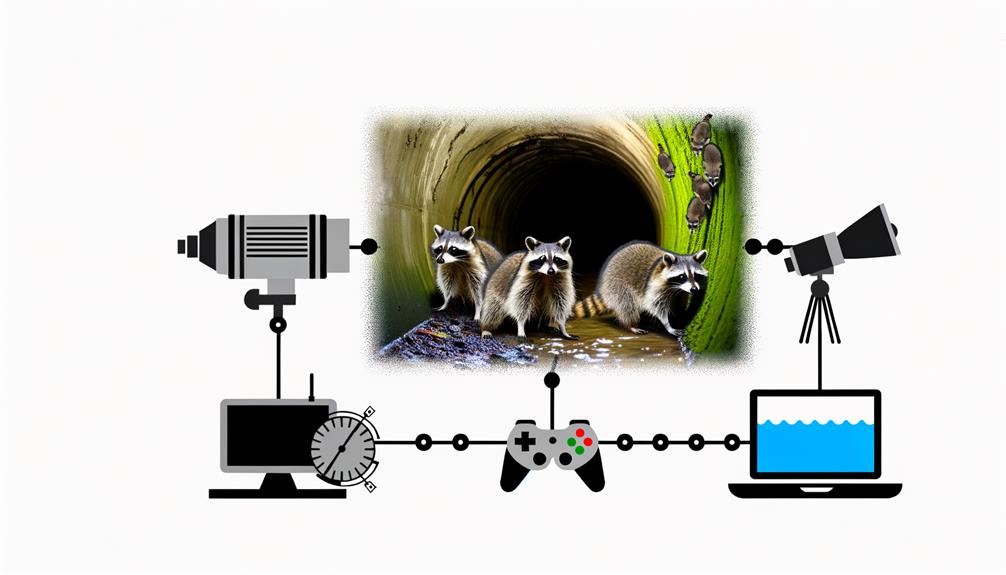
Recent scientific studies have investigated the behavior and habitat preferences of raccoons, shedding light on their potential use of urban sewer systems. These studies employ various methodologies to understand raccoon ecology in urban environments.
Key findings include:
- Tracking and GPS Data: Researchers have utilized GPS collars to monitor raccoon movements, revealing frequent use of underground infrastructures.
- Camera Traps: Surveillance in sewer entrances has captured nocturnal activity, indicating that raccoons enter and exit these systems regularly.
- Diet Analysis: Examination of raccoon diet through scat analysis shows consumption of food items commonly found in urban waste, correlating with sewer exploration.
- Population Density Studies: Higher raccoon densities in urban areas suggest that sewers may offer shelter and resources compared to natural habitats.
These findings provide an evidence-based understanding of raccoon behavior in urban settings.
Human Encounters
Human encounters with raccoons often occur during unexpected nighttime sightings, particularly in common urban locations such as residential areas and city parks.
These interactions necessitate safety precautions to mitigate potential hazards, including disease transmission and property damage.
Understanding these encounters can inform effective wildlife management strategies in urban environments.
Unexpected Nighttime Sightings
Numerous documented reports indicate that unexpected nighttime sightings of raccoons in urban environments often occur near sewer entrances or storm drains. These sightings are commonly characterized by specific behaviors and environmental conditions that facilitate raccoon activity. Observational data highlight the following:
- Foraging Behavior: Raccoons are often seen scavenging for food scraps near sewer grates.
- Nocturnal Activity: The sightings typically occur during nighttime hours, aligning with raccoons' nocturnal nature.
- Shelter Seeking: Sewer systems provide a refuge from predators and harsh weather conditions, making them attractive shelters.
- Human Interaction: Increased urbanization has led to more frequent raccoon encounters, as these animals navigate human-dominated landscapes.
These factors collectively underscore the adaptability of raccoons to urban settings and their use of sewer infrastructure.
Common Urban Locations
In addition to their presence near sewer entrances, raccoons are frequently encountered in various urban locations where human activity provides ample food sources and shelter opportunities. These adaptable mammals are often found in residential areas, especially near trash bins, compost piles, and pet food dishes, which serve as convenient food sources.
Additionally, raccoons exploit attics, garages, and abandoned buildings for shelter. Studies indicate that urban environments offer raccoons a higher caloric intake compared to rural areas, facilitating their proliferation. Observational data show that raccoons are nocturnal, increasing the likelihood of human encounters during nighttime hours.
This behavioral pattern underscores their adaptability and opportunistic foraging strategies, making urban areas ideal for their survival and reproduction.
Safety Precautions Needed
When encountering raccoons in urban environments, it is crucial to implement safety measures to mitigate the risk of disease transmission and potential aggression. Raccoons are known carriers of diseases such as rabies and leptospirosis, posing significant health hazards to humans. Additionally, their defensive behavior can lead to encounters that may result in harm.
Evidence-based strategies for minimizing these risks include:
- Avoid direct contact: Maintain a safe distance from raccoons to prevent bites or scratches.
- Secure garbage bins: Use raccoon-proof lids to decrease attractants.
- Do not feed raccoons: Providing food to wildlife can foster dependency and increase human-wildlife interactions.
- Report unusual behavior: Notify local wildlife control if raccoons display signs of illness or aggression.
Implementing these measures guarantees safer coexistence in shared urban spaces.
True Raccoon Homes

Raccoons primarily inhabit woodland areas, utilizing tree cavities, abandoned burrows, and dense foliage as their natural shelters. Evidence indicates that these habitats provide essential elements for their survival, such as protection from predators and extreme weather conditions.
Raccoons demonstrate a high degree of adaptability, occasionally expanding their habitat to urban and suburban environments when natural resources become scarce. In these areas, they may seek refuge in attics, basements, or under decks. Despite their occasional presence in urban infrastructure, research shows that sewers are not their preferred habitat. The lack of adequate shelter and higher risk of flooding make sewers suboptimal.
Understanding their true homes helps in implementing effective wildlife management and conservation strategies.
Conclusion
Upon objective analysis, it becomes evident that raccoons, while adaptable and resourceful, favor arboreal and terrestrial environments over subterranean sewer systems. Urban legends perpetuate misconceptions about their nesting habits.
Scientific studies support their inclination for more natural habitats, despite occasional forays into human infrastructure. Human encounters with raccoons in sewers are exceptions rather than the rule, emphasizing the need for accurate representation of raccoon behavioral ecology in public discourse and urban wildlife management strategies.






